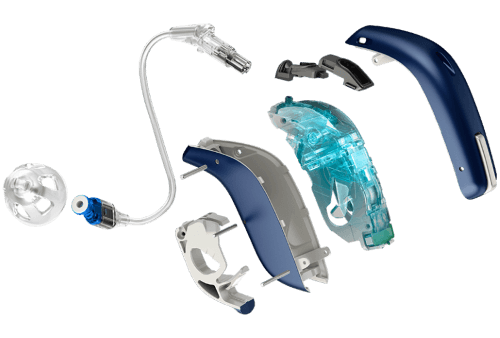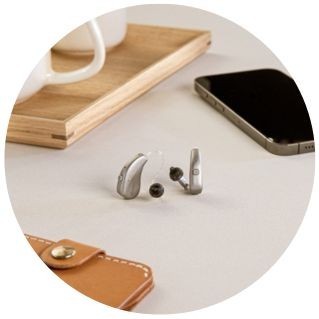How does a hearing aid work?
A brief look inside today's modern digital hearing aids
Modern hearing aids are more advanced
Today's digital hearing aids are discreet and unobtrusive even though they include the most advanced technology out there. Said technology assists in empowering those with hearing loss to live a better quality of life with better hearing.
You might have just started researching hearing aids or may be wondering how your hearing aids cannot only enhance your soundscape but also give you access to advanced Bluetooth connectivity and personable focus.
What is a digital hearing aid?
A digital hearing aid is an electronic device that you either wear inside your ear or behind your ear. These types of digital hearing aids are generically called: Behind-the-Ear (BTE) or In-the-Ear (ITE) hearing aids. A hearing aid amplifies sounds so that those with hearing loss can better hear, communicate, connect, and get the most out of their lifestyle.
However, those with hearing loss don't see hearing aids as just an amplifier - they see them as more of a lifeline. A clever and sophisticated communication device that can empower the hearing impaired - so they live life to the fullest.
Digital hearing aid quality and clarity
The better the quality of the hearing aid the better the sound and the more natural your listening experience will be. Device features like noise management, feedback manager, automatic volume regulator, and bandwidth make a realistic soundscape possible.
Modern advanced hearing aids offer impressive ranges of features, settings, and personalised options, so the wearer can experience the best possible sound for their needs and connect wirelessly to devices and the world.
All digital hearing aids analyse, filter, and boost all relevant sounds. The sound you hear is all based on the way your hearing aids have been programmed. Your audiologist will program your hearing aids to suit your hearing needs - based on your type of hearing loss.
Digital hearing aid parts
In all good and modern digital hearing aids, there are basic components - microphones, amplifiers, loudspeakers, batteries, and processing chips. The processing chip assists the advanced technology and the batteries provide the power to do so. The three main pieces of technology that ensure the functionality of the hearing aid are the microphone, amplifier, and speaker.
Here are the functions of the main digital hearing aid parts
How do hearing aid amplifiers work? The microphone receives the sounds, switches the sound waves into electrical signals, and transmits them to the amplifier, which then increases the power and level of the signals and finally sends them to the ear through the speaker.

How a hearing aid works
A simple breakdown of how a hearing aid works
- Small microphones pick up the sound around you. The microphone converts these acoustic signals into electrical signals.
- These sounds are analysed by a processing chip and these processed sounds are then sent to the amplifier. Many modern hearing aids incorporate digital signal processing technology that analyses and processes electrical signals, making adjustments based on the individual's specific hearing needs.
- The amplifier increases the strength of the signals while maintaining their clarity and fidelity. Amplified sounds are then sent to the loudspeaker.
- Then the sounds are sent by the loudspeaker into the inner ear, through tubing in an ear mould in the ear canal, or through a thin wire to a receiver in the ear.
- In the inner ear, the receiver converts the electrical signals back into acoustic signals, which are then directed into the ear canal.
- Impulses are finally sent to the brain where they are processed.
How can digital hearing aids help?
How well do digital hearing aids work? Hearing aids are used to improve hearing and speech understanding for those with hearing loss. A hearing aid amplifies sound vibrations that go into your ear.
Those with hearing loss generally have surviving hair cells that recognise the most powerful sound vibrations and then switch them into neural signals to be sent to the brain.
Want to know more about digital hearing aids?
Hearing aids are highly customisable electronic devices designed to improve the hearing ability of individuals with hearing loss. They work by amplifying sounds and delivering them directly into the ear.
The settings and programming are adjusted by a hearing care professional to match your specific hearing loss, lifestyle, and preferences. This is why regular visits to a hearing healthcare provider are recommended for proper fitting, adjustment, and ongoing support.
Call us free on 0800 567 7621 for support and advice, as well as to put you in touch with your local audiologist for your future hearing healthcare needs.
Other information about digital hearing aids:
►Digital hearing aids with Bluetooth
►Rechargeable digital hearing aids
►Digital hearing aids for tinnitus
What are the benefits of digital hearing aids?
- Selectively amplifies sounds for a more advanced listening experience
- Reduces feedback like wind and noise
- Automatically adjusts the volume to the environment you are in - even on the go
- Uses directional microphones to better understand where sound is coming from and to give you a full soundscape
- Improves sound quality - often in real-time
What's included in our hearing aid prices?
Our specialist service includes:
Do not spend hundreds of pounds without getting a second opinion from us.
Please call us on 0800 567 7621
 Not only are the prices great, but the service is fantastic! Many thanks to your team.
Not only are the prices great, but the service is fantastic! Many thanks to your team.Watch the video below from Phonak about how hearing aids work
Other pages you might find useful
Common FAQs about how a hearing aid works
How do hearing aids work and help your hearing?
A digital hearing aid is an electronic device that you either wear inside your ear or behind your ear. A hearing aid amplifies sounds so that those with hearing loss can better hear, communicate, connect and get the most out of their lifestyle.
What are the main functions of a hearing aid?
The microphone receives the sounds, switches the sound waves into electrical signals and transmits them to the amplifier, which then increases the power and level of the signals and finally sends them to the ear through the speaker.
What are the main components of a hearing aid?
In all good digital hearing aids today, there are basic components - microphones, amplifiers, loudspeakers, batteries (either traditional or rechargeable) and processing chips.
Ask the Experts
6 Morton Lane
Walkwood
Redditch
Worcestershire
B97 5QA
Latest Launch
When we refer to a product as 'Latest Launch', we mean it is the latest to be released on the market.
New
When we refer to a product as 'New', we mean that the product is the newest hearing aid model on the market.
When we refer to a product as 'Superseded', we mean that there is a newer range available which replaces and improves on this product.
Older Model
When we refer to a product as an 'Older Model', we mean that it is has been superseded by at least two more recent hearing aid ranges.
